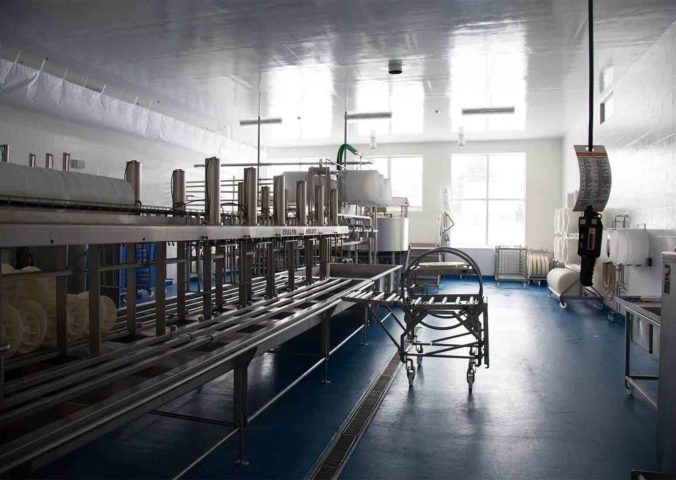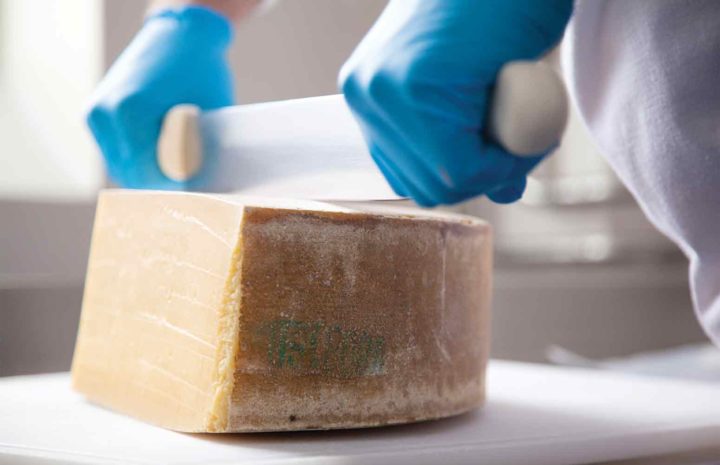In the Field: East Hill Dairy & Creamery

A dairy family in Wyoming County is the only producer of the Alpine-style comté cheese in the United States
This article originally appeared in the April 2019 edition of Buffalo Spree Magazine. Photo by Eric Frick.
Dairymen often do what their dads did. What their granddads did. Sometimes, they’ll look to see what other farms down the road or abutting the far pasture are doing, maybe get some ideas. It’s not that dairies don’t evolve—they do—but tradition, expense, and risk, especially in the milk business where margins are paper-thin, mean things just tend to be done a certain way.
So, where does someone who wasn’t raised in a milking parlor get guidance when they’re dead-set on producing happy cows and world-class cheese? For Gary and Betty Burley, the answer is: everywhere—including half way around the globe.
The Burleys own East Hill Farm and Creamery in Wyoming County. The dairy farm sits atop East Hill overlooking the town of Warsaw on Route 20A, straddling a strip of country roadway lined with corn fields, red barns, silos, and wind turbines. The Burleys bought the dairy when Gary got out of the army in 1980. A Warsaw native, Gary had worked on farms to earn spending money growing up, but counted himself a constant student when it came to creating his own style of dairy.
For ten years, the Burleys milked forty cows that grazed on green pastures. But as the dairy business got tougher, East Hill had to expand to survive. It went from forty cows to two hundred in 1991 in order to produce enough milk to join a cooperative, milking three times a day in a confinement barn typical of traditional dairies in the region. But the cows weren’t happy with the arrangement, and neither was Gary. He wanted to go back to grazing the cows on pasture, but didn’t know if it was possible with a herd that big. Nobody else was running a dairy this way locally, and, in 1995, he couldn’t just ask Google for instructions. So he traveled to Ireland and New Zealand, where large-scale grazing dairies are commonplace, to learn from farmers who had been moving milking herds to fresh grass for generations.
“It’s a whole different philosophy there,” he explains. “We were so thirsty for knowledge, and that’s where we learned how we could graze and milk seasonally here, too.”
Over the next four years, East Hill transitioned to a whole new way of doing things. Instead of standing in a barn all day, cows move to new grazing pasture before their daily milking, rotating between fresh blocks of grass with military precision according to a giant color-coded map of the property. The cows are only milked when the grass is available, and allowed to “dry off” over the winter. When the cows aren’t being milked, the humans are still hard at work sustainably managing the farm’s forests and chopping the hundred cords of wood needed to heat the farm’s buildings. As temperatures warm and woodpiles dwindle, attention turns to calving. The farm raises all of its own bulls, whose carefully kept eight-week schedules of conjugal visits produce a flurry of babies and fresh milk come spring.
As East Hill’s operational proficiency grew, so did the family and the property lines. Of the Burleys’ five kids, four work on the dairy and one is in the service. The clan eventually purchased ten other pasture parcels surrounding their property, mostly from farmers who retired from the corn and hay business without a next generation to take over, expanding East Hill Farm to just about a thousand acres. But they’re done growing—for one simple, practical reason.
“A cow won’t walk more than a mile and a quarter to the milking parlor one way,” explains Gary.
As the dairy settled into its new routine, Betty started experimenting with making cheese at home using the fresh milk from their cows. She and Gary took a cheese-making course in Binghamton, and came away with the realization that the quality of their milk was better than what typically went into cheese. They joined the American Cheese Society to make contacts with cheese makers, whom they visited to learn, sample, and ask questions. When they tried a piece of comté made by a French cheese maker working in Wisconsin, they started chasing that style exclusively. They traveled to France to learn how to make comté from a master craftsman, who later came to Western New York to help the Burleys design their own creamery and train their head cheese maker.
In 2015, construction started on the $6 million East Hill Creamery production facility in Perry, New York, less than a ten-minute drive from the dairy. The building, aging caves, and equipment were all tailored toward making alpine-style cheeses, and all designed with future growth in mind.
By 2016, East Hill’s first cheese was born—an earthy, semifirm, three-month-aged, raclette-style cheese called Underpass. This initial offering gave way to Underpass Reserve, a firmer, bolder version that is cave-aged for eleven months, and Happy Accident, a creamy, tangy raclette that came to be an unintended favorite. Then, finally, came the comté-style cheese that sparked the Burleys’ fromage foray in the first place, and made East Hill the only producer of comté cheese in the United States. The firm, nutty cheese named Silver Lake, made in sixty-pound wheels that are aged for a full year, won a blue ribbon at the New York State Fair last year in the Farmstead Artisan Hard Cheese category.

Milk from the dairy is less than one hour old when it arrives at the creamery. Once inside the huge, pristine facility, the milk makes its way through several temperature-controlled production areas gleaming with giant stainless steel tanks and vats, where it gets heated, curdled, drained, pressed into wheels, brined, and washed. The wheels, which weigh twelve to sixty pounds each, depending on variety, are finally loaded onto wooden boards cut and milled from the dairy’s woodlot from basswood, a variety historically used for spoons and food shipping crates because it doesn’t impart flavor into food.
These boards form floor-to-cathedral-ceiling shelves inside four long, narrow, humidity-controlled cement caves specially built underground to age East Hill cheese 1,500 wheels at a time. Each wheel is meticulously flipped and rubbed with a special brine mixture once or twice a week to slowly build up a hard, edible rind, a method invented to protect cheese from spoilage long before plastic wrap and refrigerators were available. As the wheels age, the rinds darken from a pale vanilla hue to the color of Dijon mustard, then caramel, then milk chocolate.
The wheels stay in the cave until they’re ready to be cut and wrapped for sale at stores and farmers markets throughout Western and Central New York (see sidebar). The alpine-style cheeses are always available in the East Hill Creamery store alongside a variety of other local products like jams, honey, crackers, and more. When the store is closed, aficionados can shop the creamery’s online store or stop by a refrigerated vending machine outside of the creamery, which accepts cash or credit to buy a wedge of cheese and other goodies on the way to Letchworth State Park for a mid-hike picnic.

While samples and shopping are the main draws for visitors to East Hill Creamery, the Burleys have added other reasons to visit. Gary hosts behind-the-scenes cheese-making facility tours for groups of local scouts, 4-H kids, and foodies. Above the creamery and store is the Chalet at East Hill, a brand-new 9,000-square-foot rustic Alpine-inspired event space with exposed beams, a full kitchen, conference room, bridal suite, and windows peering into the cheese caves: available for rent to host weddings, proms, parties, and other special events.
It’s in the back of the Chalet where the significance of East Hill’s entry into cheese really begins to gain context. There’s an area dedicated to the history of cheesemaking in Wyoming County, with a huge map marking the locations of all the creameries that once supplied local households with cheese. Black-and-white historic photos show milk arriving in metal jugs on horse-drawn wagons, small vats of curds being stirred by mustached men in woolen vests and long aprons, wooden clapboard milking parlors with chubby farm kids playing outside.
Of the sixty-three creameries that made cheese in the region since 1891, none of them exist today. As rural populations flocked to cities like Rochester and Buffalo, cheesemakers lacked refrigeration and fast transportation to get their products to urban markets without spoiling. Others couldn’t afford the equipment to follow pasteurization laws passed in the 1930s following a tuberculosis outbreak. Like many farms in the region, some creamery owners’ kids just weren’t interested in carrying on the family business.
Today, Wyoming County is still the state’s largest dairy county, but the bounty of milk produced is sold to cooperatives, large-scale cheesemakers like Sorrento (now Galbani), and a Chobani yogurt plant in Central New York. While ninety-nine percent of East Hill Farm’s milk goes to a cooperative, the one percent that becomes East Hill Creamery’s globally inspired cheese has brought a local food tradition back home again.
